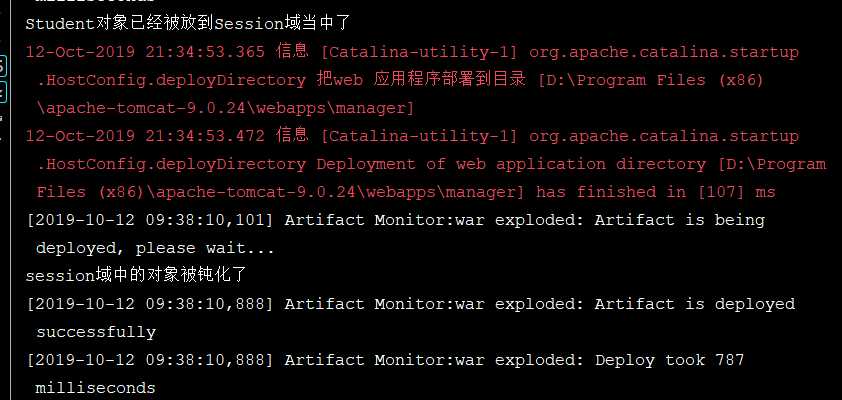标签:col 目录 ble rem tostring cep ons wap persist
与session中绑定的对象相关。
1、session的绑定与解绑:
(1)创建Person类,实现HttpSessionBindingListener 接口,用来监听session对象的绑定与解绑。
package pers.zhb.domain; import javax.servlet.http.HttpSessionBindingEvent; import javax.servlet.http.HttpSessionBindingListener; public class Student implements HttpSessionBindingListener { private String studentno; private String sname; private String sex; @Override public String toString() { return "Student{" + "studentno=‘" + studentno + ‘\‘‘ + ", sname=‘" + sname + ‘\‘‘ + ", sex=‘" + sex + ‘\‘‘ + ‘}‘; } public String getStudentno() { return studentno; } public void setStudentno(String studentno) { this.studentno = studentno; } public String getSname() { return sname; } public void setSname(String sname) { this.sname = sname; } public String getSex() { return sex; } public void setSex(String sex) { this.sex = sex; } @Override public void valueBound(HttpSessionBindingEvent httpSessionBindingEvent) { System.out.println("Student对象被绑定了。"); } @Override public void valueUnbound(HttpSessionBindingEvent httpSessionBindingEvent) { System.out.println("Student对象被解绑了"); } }
(2)创建Servlet,向Session中添加对象元素,并将对象元素移除:
protected void doGet(HttpServletRequest request, HttpServletResponse response) throws ServletException, IOException { Student student=new Student(); student.setSex("男"); student.setSname("zhai"); student.setStudentno("20171514141"); HttpSession session=request.getSession(); session.setAttribute("student",student); session.removeAttribute("student"); }

与域对象监听器不同,对象感知监听器不需要在web.xml文件中进行配置。
2、session对象的钝化与活化:
钝化:将Session中的对象持久化存储到磁盘上。
活化:将磁盘上的对象再次恢复到Session内存中。
(1)钝化:在Student类中实现HttpSessionActivationListener接口,用来监听Session中的对象的钝化与活化。
package pers.zhb.domain; import javax.servlet.http.HttpSessionActivationListener; import javax.servlet.http.HttpSessionEvent; import java.io.Serializable; public class Student implements HttpSessionActivationListener , Serializable { private String studentno; private String sname; private String sex; @Override public String toString() { return "Student{" + "studentno=‘" + studentno + ‘\‘‘ + ", sname=‘" + sname + ‘\‘‘ + ", sex=‘" + sex + ‘\‘‘ + ‘}‘; } public String getStudentno() { return studentno; } public void setStudentno(String studentno) { this.studentno = studentno; } public String getSname() { return sname; } public void setSname(String sname) { this.sname = sname; } public String getSex() { return sex; } public void setSex(String sex) { this.sex = sex; } @Override public void sessionWillPassivate(HttpSessionEvent httpSessionEvent) { System.out.println("session域中的对象被钝化了"); } @Override public void sessionDidActivate(HttpSessionEvent httpSessionEvent) { System.out.println("Session域中的对象被活化了"); } }
(2)创建一个Servlet将Student对象存放到Session域中:
protected void doGet(HttpServletRequest request, HttpServletResponse response) throws ServletException, IOException { Student student=new Student(); student.setSex("男"); student.setSname("zhai"); student.setStudentno("20171514141"); HttpSession session=request.getSession(); session.setAttribute("student",student); System.out.println("Student对象已经被放到Session域当中了"); }
(3)钝化过程:先访问Servlet,将Student对象存放到Session中,关闭服务器的时候被钝化。可以在服务器work文件夹下面查看。(.ser文件)
(4)将不经常用的Session对象钝化到磁盘上:

在META-INF目录下,创建context.xml文件,可以通过设置时间将Session中存储的对象自动钝化:
<?xml version="1.0" encoding="UTF-8"?> <Context> <!-- maxIdleSwap:session中的对象多长时间不使用就钝化 --> <!-- directory:钝化后的对象的文件写到磁盘的哪个目录下 配置钝化的对象文件在 work/catalina/localhost/钝化文件 --> <Manager className="org.apache.catalina.session.PersistentManager" maxIdleSwap="1"> <Store className="org.apache.catalina.session.FileStore" directory="dunhua" /> </Manager> </Context>

标签:col 目录 ble rem tostring cep ons wap persist
原文地址:https://www.cnblogs.com/zhai1997/p/11651085.html